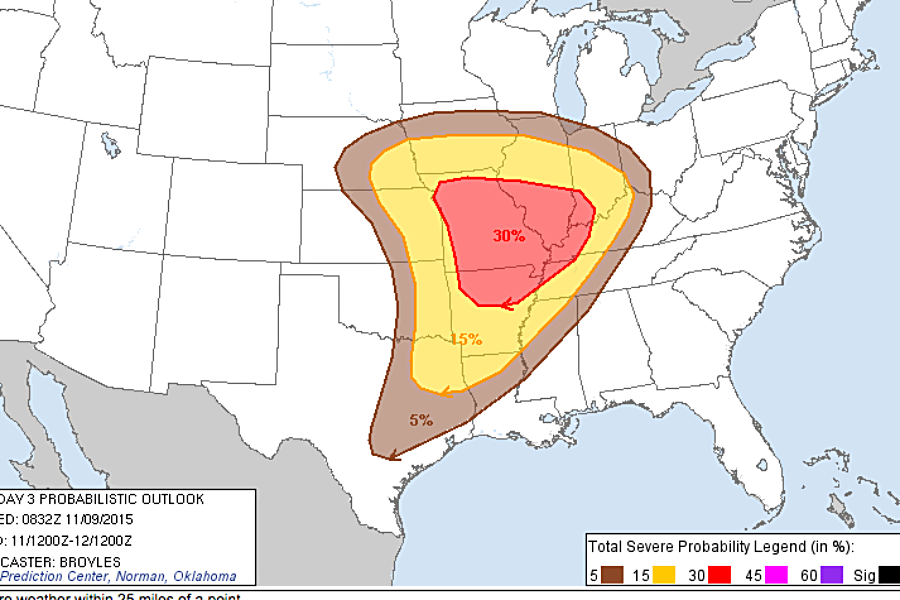Severe storm warning for 63 million Americans this week
Loading...
The national Storm Prediction Center is warning 63 million people of possibly impending storms and tornadoes in the Midwest this week.
“An increasing risk for severe thunderstorms and tornadoes is still expected for Wednesday, November 11 (Veterans Day),” the organization writes in a Facebook post Monday. “Our current expectations are for severe thunderstorms to develop in the Great Plains Wednesday morning.” The National Weather Services warns of possible hail and heavy winds.
According to the AP, the weather threat spans from San Antonio to Chicago, and then to Cincinnati. The regions forecast to face the highest risk of severe weather are Missouri, northern Arkansas, and southern Illinois.
“The severe threat should increase by afternoon as thunderstorms capable of wind damage and tornadoes move quickly eastward across the Mississippi Valley,” the Center goes on. “The severe threat should reach the Ohio and Tennessee Valleys by Wednesday evening.”
Harsh winds and disastrous weather are caused by colliding air masses. Tornadoes in particular are often born when a cold storm encounters a warm air front and creates a supercell. The cold air falls to the bottom while warm air rises, twisting and eventually forming into a funnel that rotates.
Such thunderstorms are often most damaging in the spring, but autumn storms that can spawn tornadoes are not atypical.
If you know you are within a high-threat region, the National Oceanic and Atmospheric Administration (NOAA) will issue an alert. If a tornado appears on radar in your area, a warning will be issued by the local National Weather Service office - which is typically transmitted by radio, TV, and other media outlets.
Before the storm hits, make sure you have a designated shelter – in a basement, or a windowless hallway if you are indoors.
As The Christian Science Monitor has previously reported, it’s important to also have other resources:
Each person should have a "go kit" ready to grab on the way to shelter. The go kit should include a first-aid kit, flashlight and batteries, identification, matches, copies of important financial documents, an extra set of clothes, and other items. Have a relative outside your community serve as an emergency contact so if family members are caught by the storm in different locations, they can call their status in to that relative.
If you are outside during a tornado, find the lowest spot on the ground and lie down flat with your arms over your head. The friction of the ground will slow the twisting winds, even if by only a margin, and the low position will be a smaller target for debris. The greatest risk isn't from being picked up by a tornado but by flying debris.
There are several popular misconceptions regarding tornado safety. One, the notion that opening windows to equalize air pressure in a house is simply misguided; the debris in the heavy winds will break the windows regardless, and it is these flying objects that do the most damage, not air pressure.
There is another myth that some regions are immune from tornadoes. Tornadoes have happened almost everywhere, including Alaska and Hawaii.
And after a wind funnel passes, experts advise that you remain cautious. Do not enter damaged buildings and be wary of broken power lines and gas mains. Listen for further warnings, as tornadoes sometimes come in multiples.
So far this year, there have been 10 deaths due to tornadoes.
You can follow live forecast updates at the NOAA Storm Prediction Center website here.








